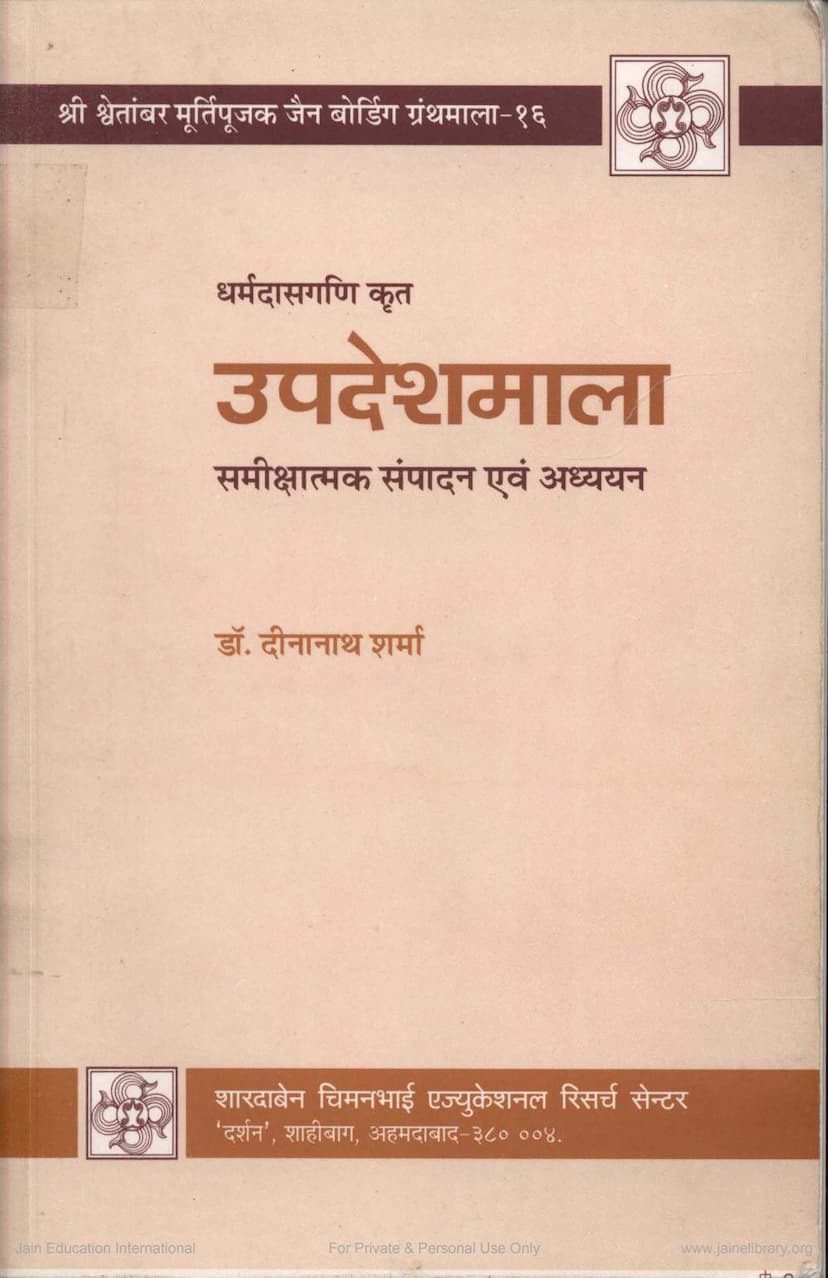Updeshmala
Added to library: September 2, 2025
Loading image...

Summary
The provided text is a scholarly critical edition and study of the Upadeśamālā (Garland of Instructions) composed by Dharmadasagani. The work was edited and studied by Dr. Dinanath Sharma and published by the Shardaben Chimanbhai Educational Research Centre in Ahmedabad in August 2000.
Here's a comprehensive summary based on the provided pages:
About the Work (Upadeśamālā):
- Author: Dharmadasagani, believed to be from the 4th-5th century BCE, although modern scholars place him in the 4th-5th century CE.
- Significance: It is considered the oldest and one of the finest Prakrit works in Jain didactic literature. It contains instructions related to the conduct of the four-fold Jain community (monks, nuns, laymen, and laywomen).
- Style: It established a unique literary style that was later adopted by many Jain scholars, leading to the composition of numerous similar works. The text uses simple verses to present didactic subjects, often interwoven with well-known stories from Jain Puranas as illustrative examples.
- Popularity and Influence: The accessibility of its verses made it easy for monks and householders to memorize and recite. Its popularity led to the writing of approximately 24 didactic treatises based on its pattern and over 32 commentaries, both extensive and brief.
- Historical Context: The language of the Upadeśamālā is identified as Jaina Maharashtri, showing influences of Ardhamagadhi. Its dating is a subject of scholarly debate, with traditions placing Dharmadasagani as a contemporary of Mahavira, while linguistic and content analysis suggests a later period, likely the 4th-5th century CE or even the 6th-7th century CE.
The Critical Edition by Dr. Dinanath Sharma:
- Need for Critical Edition: The publisher notes that existing manuscripts and published editions of the Upadeśamālā contain numerous errors, lapses, and variations in readings, particularly in grammar and meter. This necessitated a critical re-evaluation.
- Methodology: Dr. Sharma's edition involved the meticulous study of eight manuscripts (seven palm-leaf and one paper), with the oldest being a palm-leaf manuscript from Jaisalmer dating back to V.S. 1192. The editorial process aimed to establish the correct form of readings by comparing manuscripts, applying linguistic and grammatical principles, and considering prosody. Textual variations are provided in footnotes. Efforts were made to correct metrical errors and linguistic inaccuracies.
- Manuscript Analysis: The introduction details the characteristics and dating of the various manuscripts used, highlighting their strengths and weaknesses in terms of age, clarity, and linguistic accuracy.
- Linguistic and Metrical Study: A significant portion of the introduction is dedicated to a linguistic analysis of the Prakrit used in the Upadeśamālā, examining phonological changes, noun and verb morphology, and specific grammatical features. The metrical structure, primarily using the Gāthā (Āryā) meter, is also discussed, along with the presence of a few verses in Anuṣṭubh, Rathoddhatā, and Viparita-Ākhyānakī meters.
- Content Analysis: The work includes a detailed study of the thematic content of the Upadeśamālā, covering topics such as:
- The glory of the Guru.
- The prominence of ascetics (śramaṇa).
- The importance of self-knowledge and adherence to Dharma.
- The consequences of attachment, hatred, passions (kaṣāya), and suffering from worldly attachments.
- The significance of penance (tapas) and self-control.
- The importance of humility (vinaya) and avoiding pride.
- The nature of karma and its impact.
- The teachings on detachment, impermanence of life, and the pursuit of liberation.
- Illustrative Narratives: A significant part of the edition is the detailed retelling of numerous stories (dṛṣṭāntas) embedded within the Upadeśamālā. These include stories about:
- Candanābalā
- Sambādhana Raja
- Marata Chakravarti (son of Rishabhadeva)
- Prasannachandra Rajarshi
- Bahubali
- Sanatkumāra
- Brahmadatta Chakravartin
- The killer of Udāyi King
- Jāsa Sāsā
- Mrigavati
- Jambuswami
- Chilātiputra
- Dandagakumāra
- Skandakacharya
- Harikeshbala Muni
- Vajraswami
- Nandisena Muni
- Gajasukumar Muni
- Sthulimadra
- Singugufavasi Muni
- Pithamāhapitha Muni
- Tamlitāpasa
- Shalimadra
- Avanti Sukumala
- Baladeva Muni, Rayakara, and Mriga
- Puragatapas
- Varadatta Muni
- Chandravatasaka Raja
- Sagarachandra Kumara
- Kamadeva Shravaka
- Dramaka
- Drdhaprahari Muni
- Sahasramalla Muni
- Chulani Rani
- Chanakya
- Parashurama and Subhumachakri
- Aryamahagiri's Gachchatyāga
- Meghakumara
- Satyaki Vidyadhara
- Chandra Rudracharya
- Angāramardakacharya
- Pushpachula
- Anika Putra
- Marudevi Mata
- Sukumalika
- Mangu Acharya
- Girisuka and Pushpashuka
- Shailakacharya and Pankaya disciple
- Nandisena Muni (again)
- Kundarika and Pundarika
- Shashiprabha Raja
- Pulinda Mīla
- Vidyadātaa Chāndāla
- Atisnnāni Tridandi
- Kapataśapa Tapasvi
- Durdurāṅkadeva
- Sulas
- Jamali
- Shrīkṛṣṇa's brief biography
- Kogikaraja's story
- Shashiprabha Raja's story (again)
- Chilātiputra (again)
- Shrīmarudevi Mata (again)
- Shālimadra (again)
- Dharmadāsa Gani's narrative of former births
- Panchamukha Gathā
- Vajraswami (again)
- Abhimanyu
- Mahavira's previous births (including the story of Marichi)
- Gajasukumar (again)
- Dharmadasagani's concluding verses.
The edition aims to provide an accurate and scholarly version of this important Jain text, making its valuable teachings and narratives accessible to modern readers.